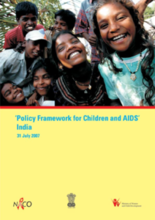It is estimated that 70,000 children below the age of 15 are infected with HIV in India and 21,000 children are infected every year through mother to child transmission. Nearly half of reported AIDS cases are in the 15–29 age group. Yet, India has a unique opportunity to use her strengths – low prevalence, concentrated epidemic, rapidly increasing ART coverage, strong government structures and family safety nets, growing recognition and advocacy for human rights and a robust media – to free the next generation from the burden of AIDS.
The Government of India is committed to preventing HIV-infections and mitigating the medical impact of the virus on the lives of those already infected. It has already provided a detailed vision of how it proposes to do so in the National AIDS Control Programme 2007–2012 (NACP III). However, while the NACP III focuses on ensuring that HIV-positive children receive medical treatment and after-care, access to schooling, adequate nutrition and a safe environment, this Policy Framework seeks to broaden the focus to address the needs of the overwhelming majority of children affected by HIV/AIDS in recognition of the fact that the virus is seen to have a profound and permanent effect on their lives. It addresses the need for a simple yet comprehensive Policy covering a broader agenda, spanning both the medical and socioeconomic dimensions of the epidemic as it affects children.
The Policy Framework adopts a rights based approach. It takes into account recent changes in the global understanding of the adverse impacts of HIV/AIDS on children, and of the best ways to address them. It is cognizant of advances in medical science. The first priority of this Policy is to prevent HIV infection, in order to ensure an AIDS-free generation. The Policy Framework also recognizes the futility of trying to differentiate between children in distress, and affirms the need for a universal approach in addressing the needs of all children subjected to social exclusion, neglect and abuse, including those affected by HIV/AIDS. This implies that these children and adolescents are provided with equitable access to social services and opportunities, without in any way compromising on the need to ensure prevention of infection among adolescents most at risk.
The Policy on children and HIV/AIDS also seeks to broaden the partners to implement the vision, the guidelines and the interventions proposed herein. It provides a mandate and a framework for government departments working at all levels of governance for the welfare of children to collaborate and also establishes a mechanism to coordinate the efforts of civil society, NGOs and the private sector, non profit and for profit in the achievement of its aims and objectives.
©UNICEF

